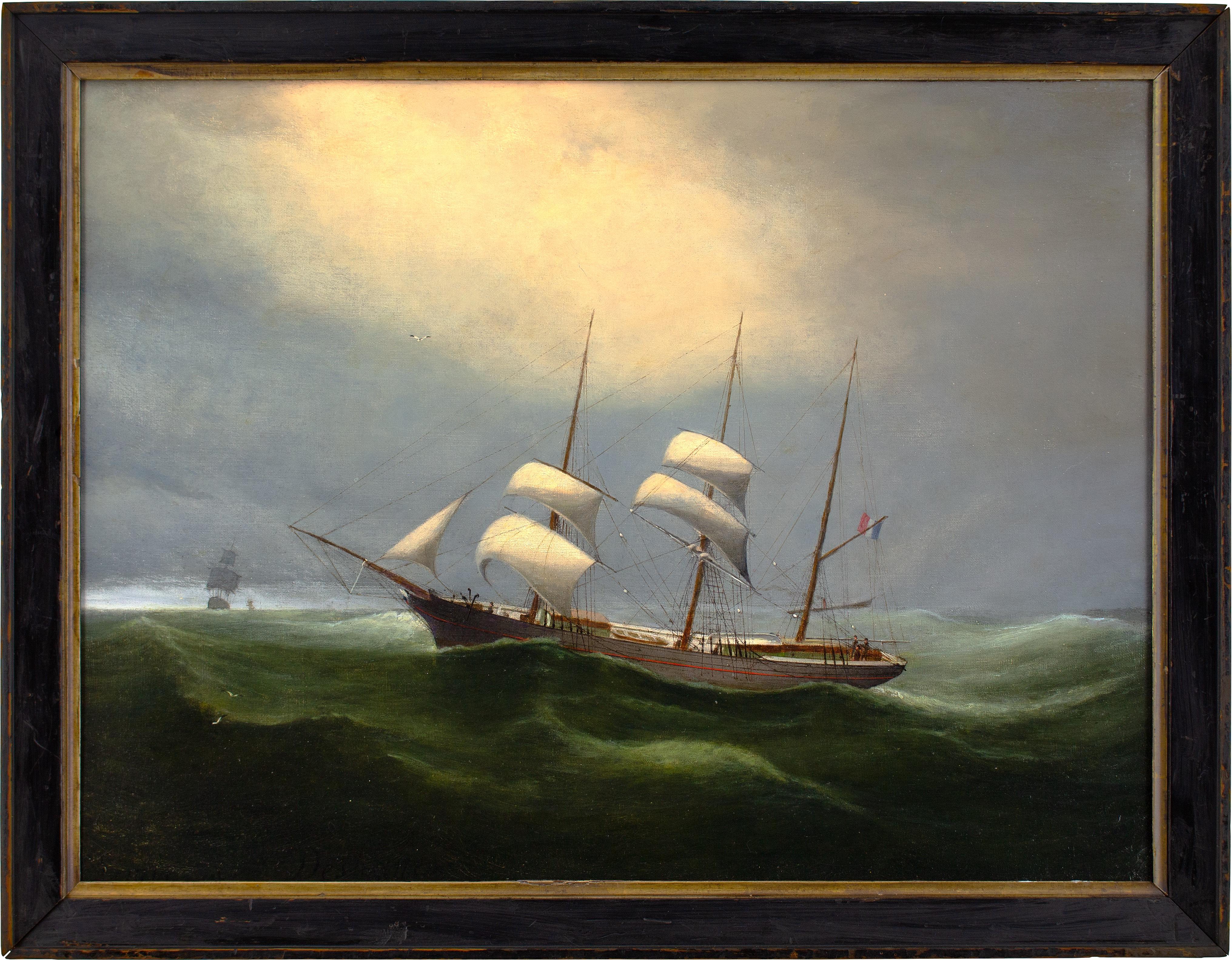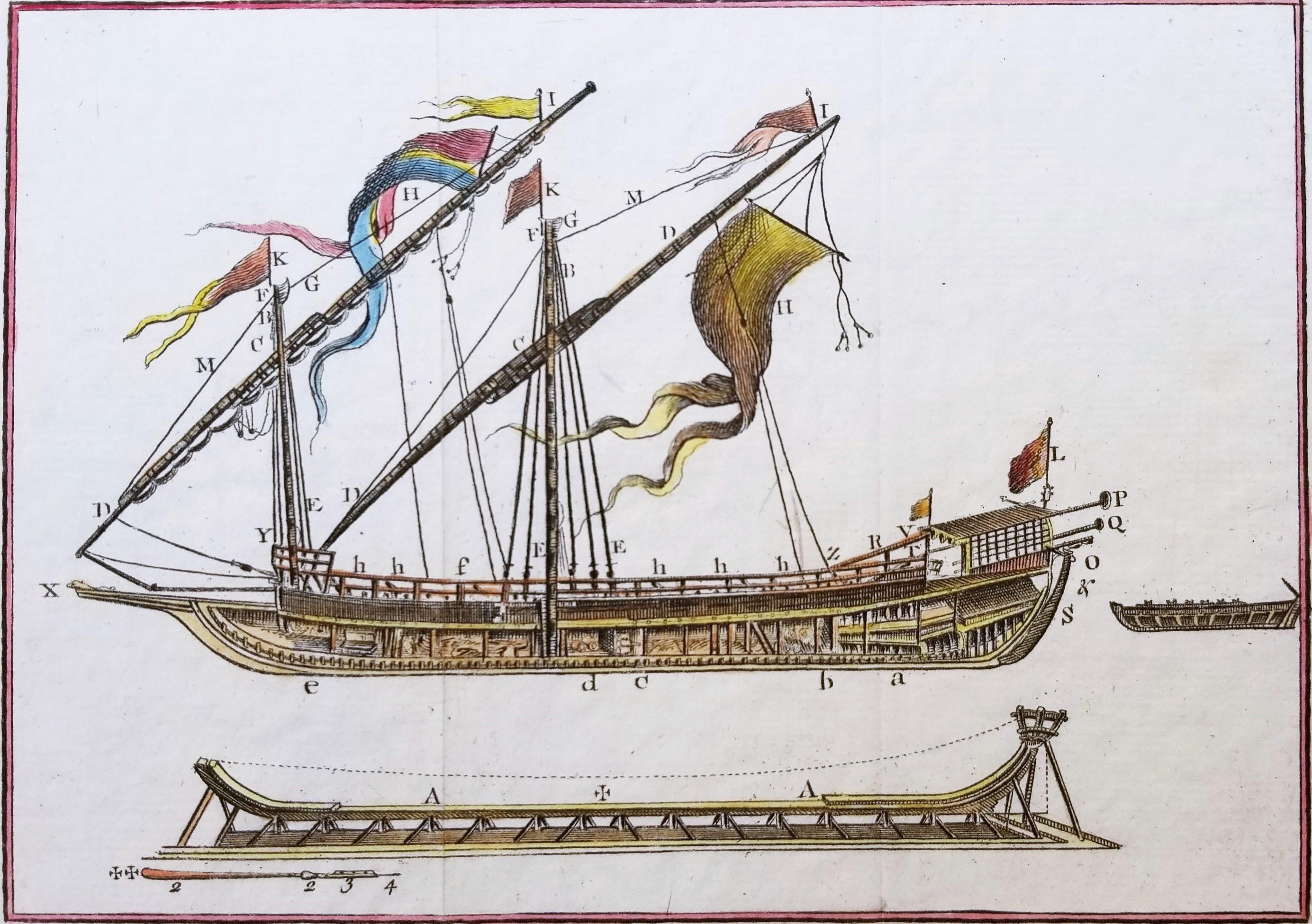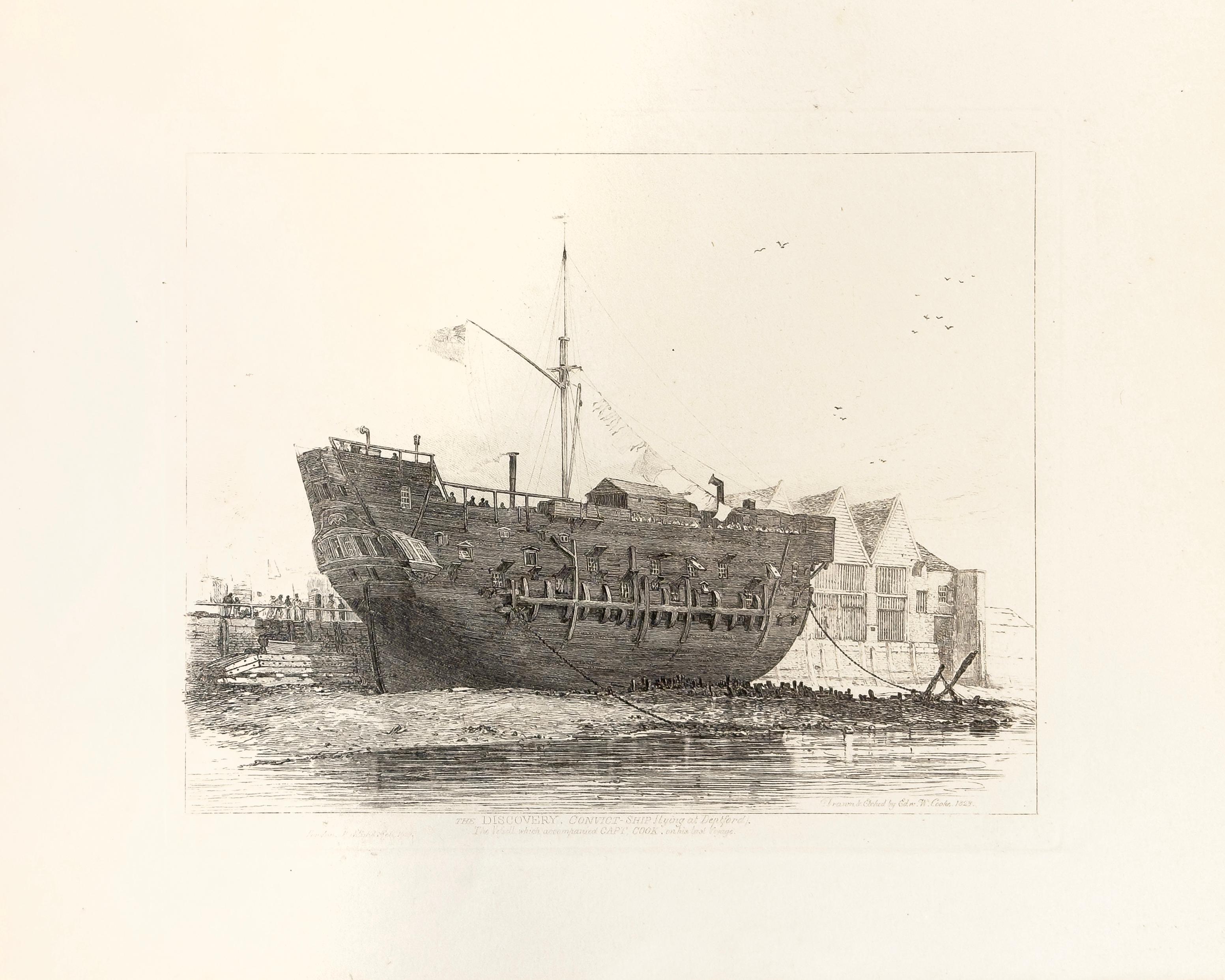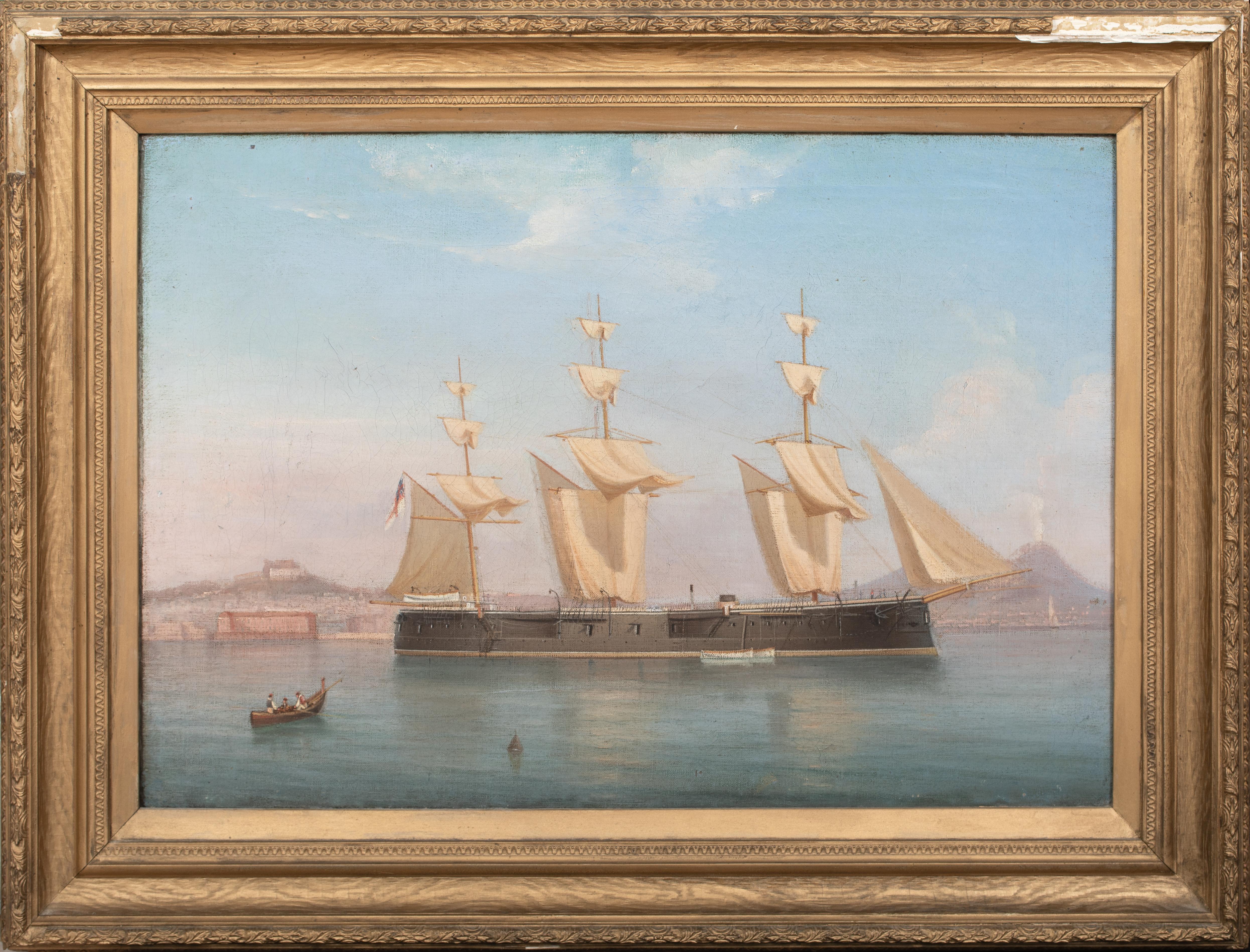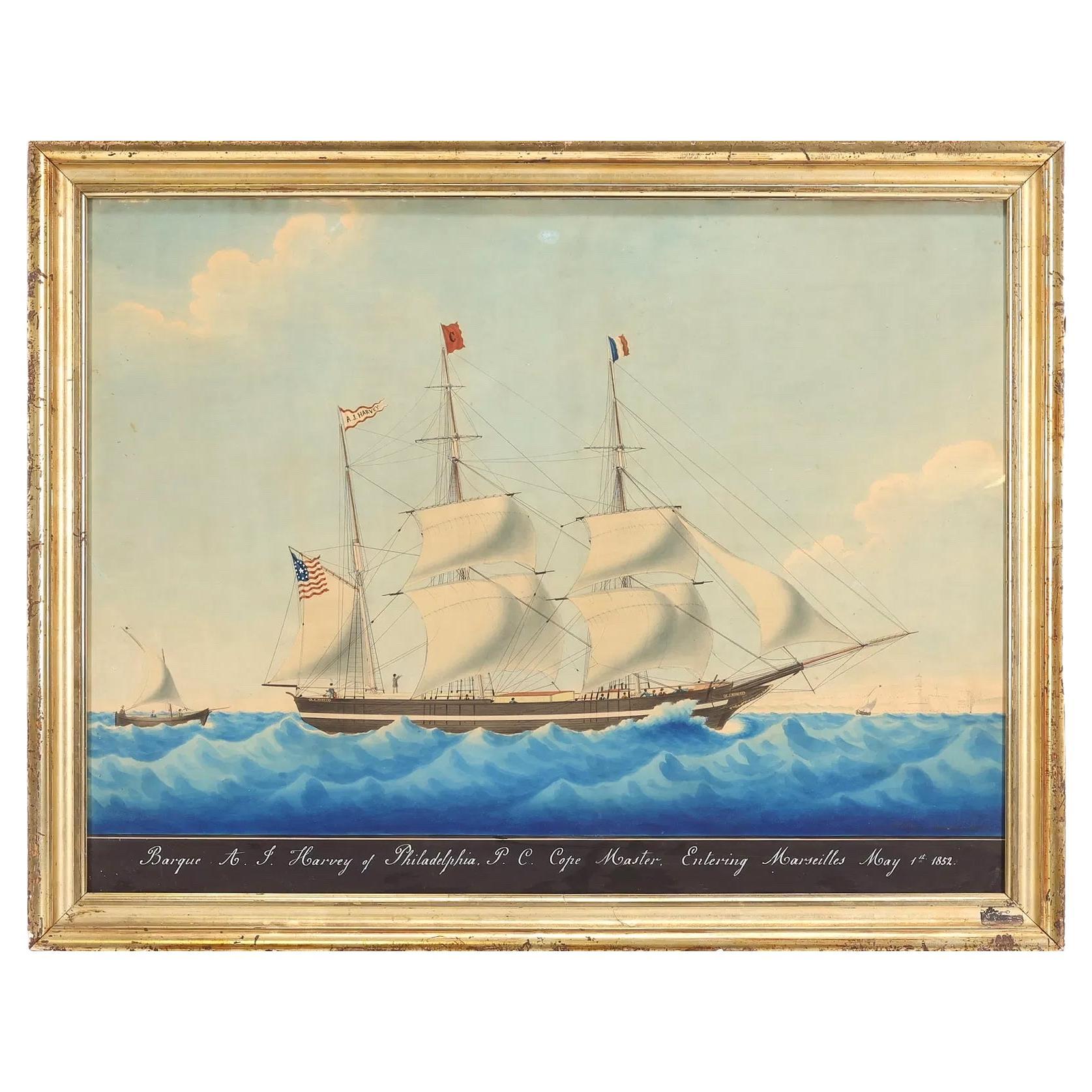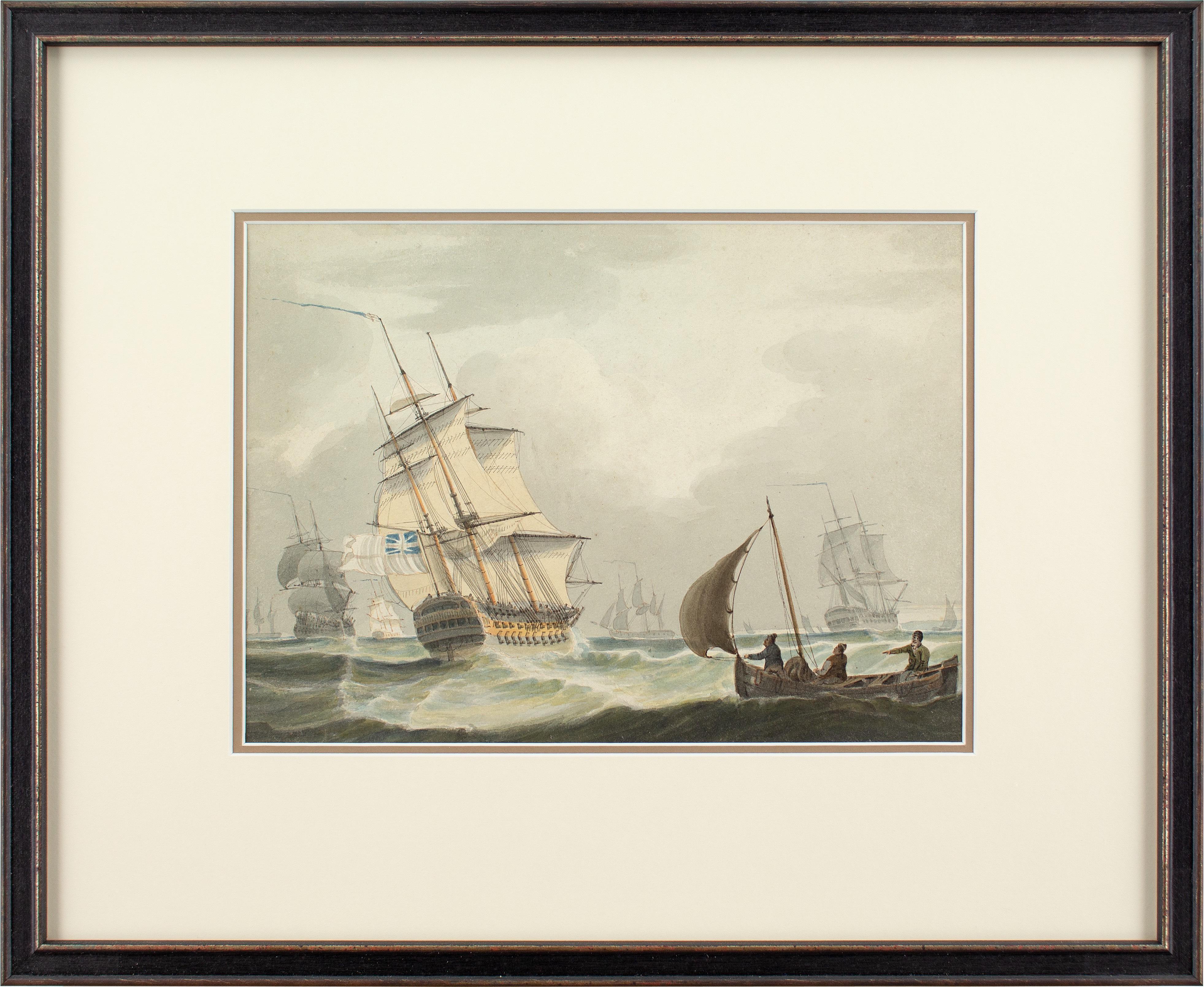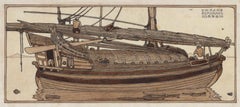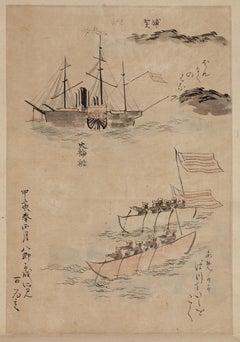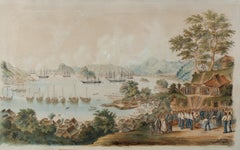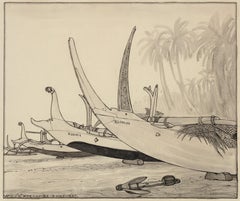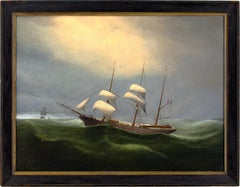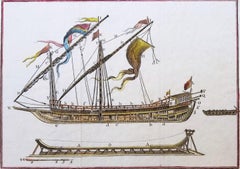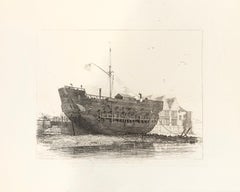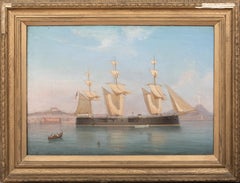Items Similar to Portrait of a Slave Ship: 'Le Negrito à l’ancre. Dans le port de la havanne'
Want more images or videos?
Request additional images or videos from the seller
1 of 2
François Mathurin Adalbert, Baron de CourcyPortrait of a Slave Ship: 'Le Negrito à l’ancre. Dans le port de la havanne'1832
1832
$49,724.62
£37,179.10
€42,000
CA$69,637.59
A$76,558.61
CHF 39,574.34
MX$916,072.64
NOK 499,617.05
SEK 468,404.95
DKK 319,953.08
About the Item
FRANÇOIS MATHURIN ADALBERT, BARON DE COURCY (1805-1839)
'Le Negrito à l’ancre. Dans le port de la havanne'
Indistinctly signed lower left
Titled on the mount
Pencil and watercolour, heightened with white, on paper, 24.8 x 34.6 cm
Literature:
The present watercolour will be illustrated in:
- Prof. Manuel Garcia’s projected book on the disease and the slave trade provisionally titled “Fighting the Yellow Demon of Fever: The Struggle against Disease in the Illegal Slave Trade”.
- Prof. Micael Zeuske’s forthcoming Global history of slave trade.
Exhibited:
Mexico City, 1998, Palacio Virreinal, El Barón de Courcy, illustrationes de un viaje, 1831-1833, no. 108
Note:
Baron de Courcy was in the Caribbean in late 1832 and early 1833, following his tour of Mexico in 1832, on the last leg of his “Grand Voyage Américain” which had begun with the eastern seaboard and waterways of Canada and the United States in 1831. He had sketched the great natural wonders of the New World en route, from Niagara Falls to the Mexican sierra, but the present watercolour of the slave ship Negrito is undoubtedly the most arresting of all of his American paintings.
De Courcy paints the deck of the ship, where some of the slaves, probably mainly the women, were sheltered beneath spare furled sails when the ship was anchored. When sailing the slaves were stowed in the lower decks and only when these were completely full some had to stay on loose boards above the water running across the deck.
This watercolour places De Courcy in Havana in December 1832, as the Negrito is recorded as arriving in the port with its “cargo” on 11 December 1832. The details of the slaver’s voyage are recorded in detail on the “Voyages” list in “The Trans-Atlantic Slave Trade Database”.
The Negrito, captained by Francisco Antonio Sarria, flying the Spanish and Uruguayan flags, sailed from Havana for the west coast of Africa on 17 June 1832. She made landfall at Whydah (Ouidah) in the Bay of Benin and departed from Africa on 20 October with 590 slaves, bound for Havana. The passage took fifty-two days, with forty-six slaves perishing on the voyage. The Negrito arrived with her 534 surviving slaves at Havana on 11 December 1832. By the early 1800s, Cuba had become the second-largest destination for slaves transported from West Africa, and in the early 1830s, after the slave trade had been made illegal, the numbers landing in Havana peaked, with twenty-two slave ships disembarking their slaves in the port. By then Havana had become the largest slave port in the world, both as receiver of slaves and as the planner of slave-voyages.
- Creator:François Mathurin Adalbert, Baron de Courcy (French)
- Creation Year:1832
- Dimensions:Height: 9.77 in (24.8 cm)Width: 13.63 in (34.6 cm)Depth: 0.79 in (2 cm)
- Medium:
- Movement & Style:
- Period:
- Framing:Frame IncludedFraming Options Available
- Condition:
- Gallery Location:Amsterdam, NL
- Reference Number:1stDibs: LU147128029072
About the Seller
No Reviews Yet
Vetted Professional Seller
Every seller passes strict standards for authenticity and reliability
1stDibs seller since 2021
- ShippingRetrieving quote...Shipping from: Amsterdam, Netherlands
- Return Policy
Authenticity Guarantee
In the unlikely event there’s an issue with an item’s authenticity, contact us within 1 year for a full refund. DetailsMoney-Back Guarantee
If your item is not as described, is damaged in transit, or does not arrive, contact us within 7 days for a full refund. Details24-Hour Cancellation
You have a 24-hour grace period in which to reconsider your purchase, with no questions asked.Vetted Professional Sellers
Our world-class sellers must adhere to strict standards for service and quality, maintaining the integrity of our listings.Price-Match Guarantee
If you find that a seller listed the same item for a lower price elsewhere, we’ll match it.Trusted Global Delivery
Our best-in-class carrier network provides specialized shipping options worldwide, including custom delivery.More From This Seller
View AllA Buginese boat, Semarang 1898
Located in Amsterdam, NL
'A Buginese boat, Semarang 1898’
Signed, dated, and annotated, upper right Pen, brush and ink on cardboard, H. 11.4 x W. 26.3 cm
Literature: Venselaar, 2019, p. 69 (ill.)
Category
Late 19th Century Landscape Drawings and Watercolors
Materials
Paper, Ink, Pencil
Scroll painting of the American ship commanded by Commodore Matthew Perry
Located in Amsterdam, NL
Attributed to Ukita Ikkei (1795-1859)
Hanging scroll painting of the American ship commanded by Commodore Matthew Perry in Uraga Bay, annotate...
Category
Mid-19th Century Edo Figurative Drawings and Watercolors
Materials
Paper, Ink
Price Upon Request
Free Shipping
1854 Funeral of R. Williams at Gyokusen-ji Temple, Shimoda, with Commodore Perry
Located in Amsterdam, NL
Wilhelm Heine (Dresden 30 January 1827-Löbnitz 5 October 1885)
‘Funeral of Robert Williams in the cemetery of the Temple Gyokusen-ji at Shimoda in April 1854’
With a sticker on the reverse of the frame by Coupil & Co. 1855
Watercolour on paper, H. 57 x W. 92 cm
Depicted is the Bay of Shimoda with seven American ships including the two paddle-wheel warships USS Mississippi and Susquehanna. On the Gyokus- en-ji temple grounds on the right is the coffin in the middle with the remains of US marine Robert Williams, ready to be lowered into the grave. Looking on from the left are the Buddhist monks and Japanese officials who joined the first Christian funeral on Japanese soil. Around the grave are US marines, Commodore Perry...
Category
Mid-19th Century Figurative Drawings and Watercolors
Materials
Paper, Ink, Watercolor, Gouache
Price Upon Request
Free Shipping
Beach of Kusambe, Bali 1937
Located in Amsterdam, NL
Four outrigger proa’s on the beach of Kusambe, Bali, 1937
Signed with initials, dated and described with location bottom left
Pencil and ink on paper, 29.7 x 35 cm
In ebonized frame with white mount
WILLEM OTTO WIJNAND NIEUWENKAMP
(1874-1950)
Nieuwenkamp was born on July 27th 1874 in Amsterdam. His father owned sailing ships sailing to Indonesia and hearing the stories of the returning captains evoked in the young Nieuwenkamp an obsession for distant lands and adventure. After a failed attempt by his father to have his son make a career in his business, Nieuwenkamp attended the Academy for Decorative Art in Amsterdam. However, he left within one year to go his own way.
He was an autodidact and a great experimenter with new techniques, particularly in the art of etching. Nieuwenkamp was a very focused man with the discipline of a scientist tempered by the sensitivity of an artist, a lust for adventure, a natural appreciation for ethnic arts and an enormous ambition to tread new paths.
In 1898 he visited Indonesia for the first time and on his second visit in 1903-1904 he went on to Bali and became the first foreign artist to love Bali and the Balinese with a passion. Having secured agreements with several museums in the Netherlands to obtain Balinese art and objects for their collections, Nieuwenkamp immediately started to purchase and order a wide range of ethnographic art and objects from local artists and craftsmen.
Through his drawings and books, he gave an excellent impression of Balinese art and culture at that time. Since 1854 Northern Bali was under Dutch...
Category
1930s Art Nouveau Landscape Drawings and Watercolors
Materials
Paper, India Ink, Pencil
View on the Governor’s Palace in Paramaribo, Surinam
Located in Amsterdam, NL
GOVERT VAN EMMERIK (1808-1882)
View on the Governor’s Palace in Paramaribo, Surinam
Signed and dated 1856
Oil on canvas, 70 x 90 cm
In large gilt...
Category
19th Century Naturalistic Landscape Paintings
Materials
Canvas, Oil
A pair of Indonesian Landscapes, by Charles Legrain (19th century)
Located in Amsterdam, NL
Charles Legrain, (19th century)
Two Javanese landscapes
Both signed Legrain Ch. and one dated 1857
Both oil on canvas, size: 95 x 114 cm
In rich gilt-gesso frame.
(2x).
Category
Mid-19th Century Romantic Landscape Paintings
Materials
Canvas, Oil
You May Also Like
Marie-Edouard Adam (Circle), The Barque ‘Limbe’ In Choppy Waters
Located in Cheltenham, GB
This late 19th-century French oil painting depicts the barque Limbe in choppy waters, with the silhouettes of two further ships beyond. It was probably produced at Le Havre, France, ...
Category
1870s French School Landscape Paintings
Materials
Canvas, Oil
Draught of a Galley /// Old Masters Ship Boat Seascape Construction Diagram Art
By William Henry Toms
Located in Saint Augustine, FL
Artist: William Henry Toms (English, c.1700-1765)
Title: "Draught of a Galley" (Plate 13, Vol. III, page 131)
Portfolio: La Spectacle de la Nature
Year: 1737
Medium: Original Hand-Colored Engraving on laid paper
Limited edition: Unknown
Printer: Unknown, London, UK
Publisher: Humphreys, London, UK
Framing: Recently framed in a Regency style gold moulding with 100% cotton rag matting and 99% UV protective Museum Glass. The frame is an antique frame we've reused, originally built by Knoedler Gallery, New York, NY
Framed size: 10.25" x 10.25"
Sheet size (irregular margins): 6.63" x 8.25"
Image size: 4.75" x 6.75"
Condition: In excellent condition with strong colors and good margins
Rare
Notes:
Comes from the 1737 volume edition of Noël-Antoine Pluche's "La Spectacle de la Nature", translated from the original French by Humphreys as "Nature Displayed". With two soft vertical folds within paper as issued. Various dealer reference numbers and an old price pencil inscribed in margins and on verso.
Biography:
William Henry Toms (c. 1700–1765) was an English engraver. He worked on portraits, book-plates, landscapes and prints of buildings. Among his works were the plates for Robert West's "Perspective Views of All the Ancient Churches in London" (1736–1739). In 1741, he worked with Thomas Badeslade on "Chorographia Britanniae or a New Set of Maps of all the Counties in England and Wales". The maps were republished on 29 September 1742, with additional place names. Among Toms's apprentices was the engraver and publisher John Boydell. W. H. Toms lived in Masham Street, London, and was the father of the painter Peter Toms. Toms died in 1765.
Noël-Antoine Pluche (1688-1761) , known as the abbé Pluche, was a French priest...
Category
1730s Baroque More Prints
Materials
Watercolor, Laid Paper, Engraving, Intaglio
29: The Discovery, Convict Ship
Located in Columbia, MO
Edward William Cooke was born in Pentonville. His father, George Cooke, and uncle William Bernard Cooke were also well-known line engravers. Growing up in an environment of artists,...
Category
1820s Naturalistic Landscape Prints
Materials
Etching
British Royal Navy Anchored Off Naples, 19th Century TOMMASO DE SIMONE
Located in Blackwater, GB
British Royal Navy HMS Encounter Anchored Off Naples, 19th Century
TOMMASO DE SIMONE (1805-1888)
Large 19th Century view of the British Royal Navy fleet off the coast of Naples, oi...
Category
19th Century Landscape Paintings
Materials
Canvas, Oil
Watercolor of the American Barque A.J. Harvey in Marseilles by Honore Pellegrin
Located in Wiscasset, ME
Watercolor featuring the American Barque A.J. Harvey. Inscribed in the lower center of the painting and with the original handwritten adn signed label on the reverse. "Barque A.J. ...
Category
Antique 1850s American American Classical Paintings
Materials
Paint, Paper
Samuel Owen (Attributed), Maritime Scene With A Royal Navy Man-Of-War
By Samuel Owen
Located in Cheltenham, GB
This early 19th-century watercolour, attributed to English artist Samuel Owen (1769-1857), depicts several vessels buffeted by turbulent waves. Owen was an accomplished British marin...
Category
Early 19th Century Naturalistic Landscape Paintings
Materials
Watercolor
More Ways To Browse
Used Ship Anchor
Niagara Falls
Painting 19th Century Sailing Ship
Ship Portrait
19th Century Ship Paintings
Mid Century Ship Painting
Le Baron
Ship Port Painting
Tommy Thompson
Umar Rashid
Versace Pen
Wellington Clock
William Edwards Cook
Yuriy Ibragimov
Black And Yellow Painting Abstract
Used Barn
1970 Oil Paintings
Pool Photographs and Photography
